Just like coaching is a blend of art and science, training alone follows a similar formula. It is a merging of anecdotal experience that has a give-and-take relationship all mixed together with some good ole fashioned trial and error.
After a solid couple of years lifting with some awesome training partners throughout college, I soon after completing my graduate assistant position found myself forced to learn how to adapt to training on my own again. Unbeknownst to me initially, I was without a lot of the important qualities that a worthwhile training partner or crew provided.
For over a decade not only have I trained in solidarity but I have done so in multiple places, states, schools, facilities and under different circumstances with varying training goals. Whether it was a commercial gym, on the road for away trips with my college teams I was coaching, to the varsity weight rooms, my storage units and now garage gym. Through these years it’s been a process of learning how to navigate and optimize training individually. So after training solo for the better part of 10 years now, I thought I would share some of the good, the bad, and the unknowns for those in a similar situation looking to make the most of training solo. In this article I want to pass along some of those lessons learned as well as showcase some of the benefits and potential drawbacks from the extended amount of time I’ve spent honing the skill of solo training.
Guide
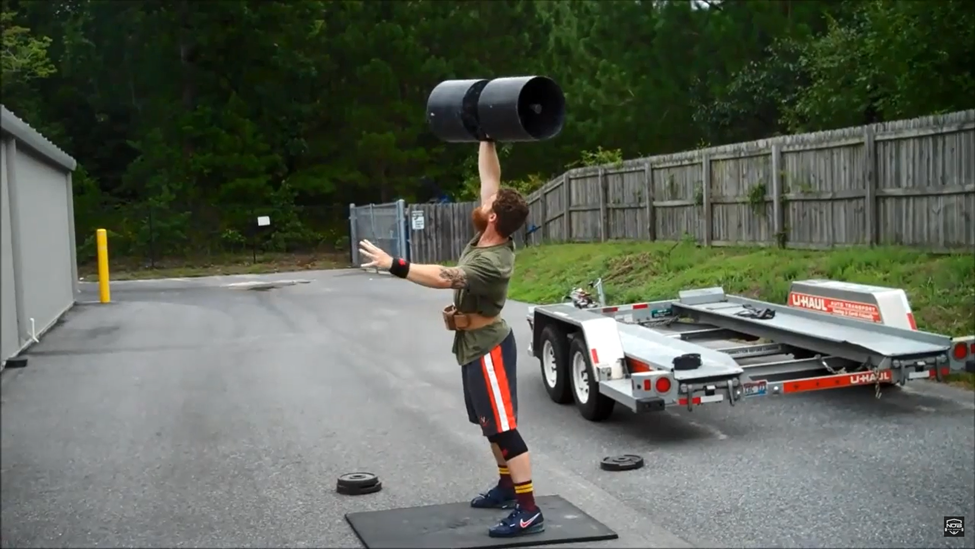
Benefits To Solo Training
Whether it’s continuing to train following a college athletic career, training in a remote area, training for a fringe strength sport or any number of other reasons, a lot of people who lift on a consistent basis end up doing so alone. There are many different situations you can classify as training ‘alone.’ You could be truly unaccompanied with no one around, in a gym with no training partner working toward the same goal or at globo-gym with simply no assistance from anyone for your lifts. Training alone may sound self-deprecating however this manner of training can have its’ upsides. Three of those benefits include:
Scheduling
Starting off on a positive note with easily one of the biggest benefits of lifting alone is simply the ease at which you can actually schedule your training sessions. Not having to wait on anyone to schedule training times affords you the opportunity to train what and when you want to. Because of this freedom of scheduling, you can also easily break up your lifts, if you so choose. You can make this decision quickly, without consulting any training partners, to pull an audible. By doing this you could, for example, do your accessory work in the morning and save your main lifts for the afternoon or really any sort of other combination you can think of. This especially comes in handy if you have other responsibilities at home or work that pop up throughout the day which could alter your schedule and impact your original training time or session plan. Changes and outside obligations are a part of life, so having the freedom to adjust your schedule is huge and comes in handy, especially if you are a coach and your work schedule is anything but ordinary, or consistent for that matter.
Training Environment
Along with the ease of scheduling, by training alone you can really set the training atmosphere. What the environment looks like, the music playing, the setup of the area, and anything else you can think of that sets the tone for each lift is up to your own discretion. Setting up your training environment when you have your own space (i.e. a garage gym, storage unit, etc.) is extremely helpful in making your training sessions streamlined and more efficient. This obviously would be much more difficult training at a commercial gym or facility in which you’re less likely to be able to limit outside distractions, but it is not impossible and there are definitely workarounds when it comes to this.
If you don’t have an exclusive space to train in that you own like a garage gym, storage unit, or keys to a private facility or weight room to use at your own time, there are still ways to set up your environment to be more beneficial to your training goals. With the sheer amount of specialty gyms nowadays, you can choose the one that fits your specific goals and needs. Finding the right training environment for your goals already aids in improving your training because those facilities are designed for the same type of goals and have set up the space to be conducive for it. For instance, if you’re a competitive powerlifter, trying to lift at CrossFit gym might not be your first choice but you could get by depending on the equipment they have, the space for platforms and the training time you’re looking to do around their normal CrossFit group classes. This certainly would beat trying to lift at a purple meathead-alarmed facility but pales in comparison to finding a true powerlifting gym where the facility is tailored to the specific type of training you are interested in. Choose the right training facility for your specific goals and you might even solve your solo training ‘problem’ by finding a training crew with similar training goals, if that’s what you are looking to do.
In addition to limiting outside distractions in your environment, you can also vastly improve your efficiency.
Yes, you might not have as much access to equipment to set up a twelve part circuit in your garage with multiple barbell exercises but you never really have that true freedom at 99% of facilities anyway. If you have the training space that is yours, such as the case of owning a garage gym, you can set up your area to be more advantageous to your type of training and your goals. You’ll likely already be doing this in a way, since you are already purchasing the equipment you like and the equipment you want for the goals you have set. In addition to this, when it comes to efficiency, since it’s your space, you can even pre-arrange equipment to improve the flow of your sessions, thus saving time. You can configure the space to how you want, add and subtract equipment as you see fit, and best of all you can always play whatever music you want.
Personal Ownership & Accountability
Really the heading for this section says it all. You alone are responsible for your own success, as well as your failures.
If you are a self-motivated, intrinsically driven, and goal oriented type of person, training alone can really favor you. There is much to be said about being surrounded by similar minded individuals to boost your training, but without that support system physically present you need to possess it yourself or fabricate it in some fashion. If you can maintain your bearing, training alone can be a great thing. Someone who is disciplined and doesn’t leave success up to chance can really thrive in an independent training scenario, especially when a lot of distractions are excluded from your space.
Again, don’t get me wrong. Being surrounded by an enthusiastic and experienced crew that is determined to exceed the standard is a great force multiplier for training success. Unfortunately, more times than not those crews are hard to come by after traditional organized team sports participation ends. It is also more difficult to find those groups training for particular strength sports or, in my case along with a lot of other coaches, training times with those groups don’t mesh with my work schedule. Training times aside, sometimes the goals of the group or commitment level doesn’t match up with what you’re looking for so because of that, training alone outweighs training with undisciplined, unmotivated, and unqualified people. In deciding this, you forfeit the right to make excuses for your failures and this means you alone are responsible for your success or lack thereof. Which for many in strength sports is a large reason they were drawn to compete in them in the first place.
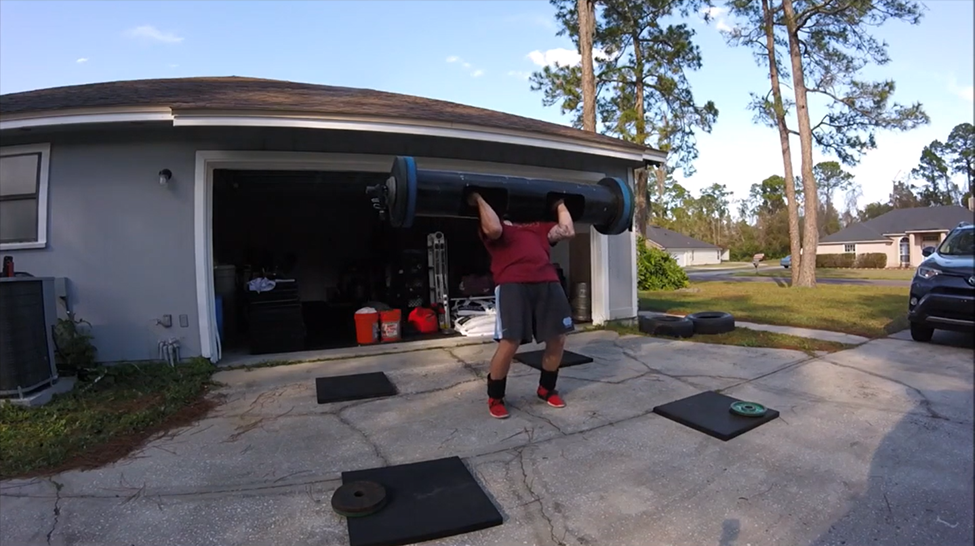
Overcoming Challenges
Most of the drawbacks to training alone stem from literally just that; training alone. If you are already committed to training by yourself by choice or are doing it by necessity, it seems a lot more beneficial to give some pragmatic advice on how to navigate some of the drawbacks rather than just point them out or try to talk you out of training alone. So without further ado, below are some workarounds and proposed ideas of ways you can go about managing these issues of flying solo in your training.
Set-up & Break-Down
At initial glance this doesn’t seem like a big deal, but just like compounding interest can make or break your financial investments, over time the extra burden of setting up and breaking down each and every lift can add up.
Let’s use my last storage unit in Fresno as an example of this. My storage unit was conveniently located in the back of the complex but was unfortunately not on the main strip. Because most people are actually using their storage containers for storing items and not doing strongman training, the walkways are not necessarily designed for the width requirements to maneuver a yoke down the pathways. The dilemma with this became transporting all the equipment I planned on training with around the building to the road in order to actually train. This may seem like no sweat off your back but when you consider all the work preparation before you actually get to train you will start to see where the inconvenience and long-term problems lie.
Transporting 100 and 45 pound plates, a yoke, cones, change plates, personal gear and whatever other odds and ends needed from the storage unit to then set it up in the main strip is fine. Now set it all up. Set up the yoke, measure out the distance, load your weights, set up the camera, etc. NOW, it’s time to actually lift. You complete your yoke runs and if you are smart, you’re setting up your next event to train during your downtime resting. Here’s where the strategy and drawback rears its ugly head. Now, after all is said and done, you have to reverse that entire setup process, return the gear to the storage unit, and strategically store all that equipment back where you got it. So hopefully you’re not completely wiped or worse, injured.
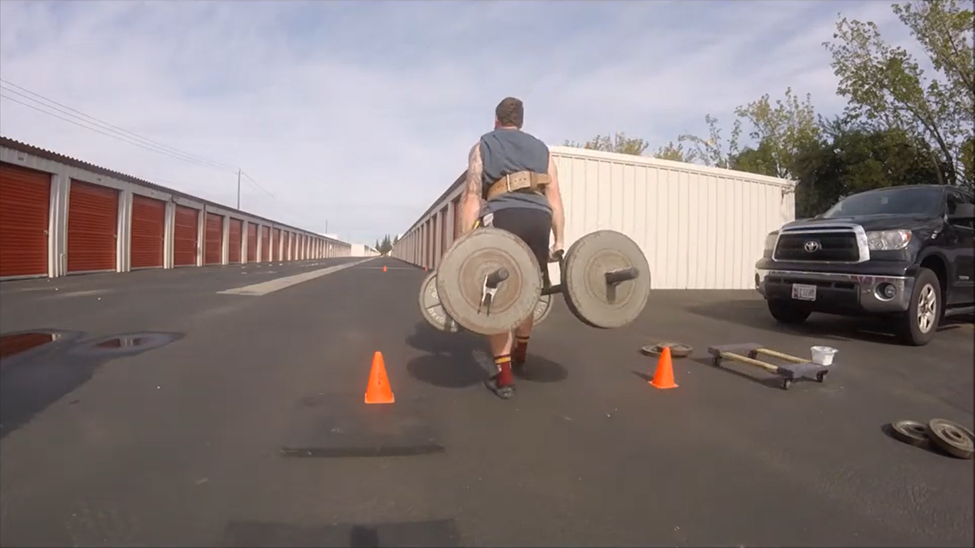
Now I understand that not all types of training will be this cumbersome in terms of setup or breakdown, but nonetheless, it will still be lengthier and more time consuming than training with a group. Training alone is much more of a process regardless if you’re training strongman, highland games, powerlifting, or what have you. No matter the strength sport, style of training, or level of training, those small components of preparing your training sessions, actually completing it, and then breaking everything down after will take a toll on you over time. Although some might not be opposed to the extra work or time requirements for the set-up and breakdown of training sessions it is still a must know piece of information going into making training alone a sustainable avenue. Keep this logistical piece of the puzzle in mind and plan this detail accordingly into your training program.
Training Feedback & Guidance
Even as a coach myself, I’d argue that every athlete, regardless of sport or training goal should have their own coach. You can define “coach” however you see fit in this instance, but I will characterize an educated, experienced, and well-meaning training partner who falls into this category. The amount an outside, unbiased, and objective second opinion can make on even just a single rep, let alone a career is immeasurable. Just being able to bounce ideas around or speak aloud to another person with different thoughts can have an immediate impact on the next decision as well as correct the last. With how important this instruction can be, finding an alternative solution to not having a training partner or solid crew around you on a daily basis in-person is a priority.
There are some viable ways to try to work around this such as videotaping training sessions, top sets, or other parts of your lift to either analyze yourself or send to a training partner or coach. Along with providing both objective and subjective feedback to the visual footage, can give whoever is viewing the recording some additional context. The issue with this is, unlike with a coach or training partner in-person, all the feedback you receive is far after the fact so no adjustments can actually be made in real time. Using this tool, although with a timed delay for feedback, is still beneficial and can make a big positive impact on your training for the long-term.
I have personally filmed a lot of my sessions if not just some of my top sets for a multitude of reasons. Firstly, it allows me to playback my lifts and be my own coach. Without another persons’ feedback in the moment I can at the very least review the tape and make my own personal adjustments based on the previous lift. Although it takes time to set up, keep lifts in frame, record, stop the recording, and then actually review it; it has proven to be very beneficial to clear up minor issues I am not aware of during the actual lift but can clearly see after the fact.
Videoing can also assist training alone in other ways like servicing as a makeshift timer, judge, motivational training ‘partner’, and coach (if you’re willing to remain as objective as possible). Taking a video of training also serves as accountability for successful repetitions, depth checks for lifts, confirming times in lieu of a stopwatch, being a digital log of previous training sessions, among other reasons.
Not having immediate feedback or guidance means there is no second opinion. There is no coaching. There is no anything, for that matter, that isn’t self-prescribed or self-inflicted. Alone you are stuck with deciphering between decisions that on any day could be a coin flip but result in vastly different outcomes. Therefore finding ways to get feedback, even if simply your own, from recording sessions, tracking training in a logbook, reviewing video footage, or other sources is a big hurdle that needs to be addressed. Figure out what works best for you, and use that to make good and smart decisions that hopefully strike a balance between being too critical of yourself and being too complimentary.
Safety & Spotters
Finally, and arguably very important, training alone means you have no safety net or spotter. This can mean no one to literally spot you for a lift or provide a liftoff. This can also mean there’s no one to warn you of or help direct incoming traffic (for those who play strongman games in the road), or help provide another set of eyes on equipment since a lot of strongman implements are self-fabricated and therefore left to the discretion of the athlete. And to hammer the point home again, no one is able to immediately watch technique or give constructive criticism. No one is there to provide any sort of immediate, in-person external feedback that may prevent a safety infraction or from doing something completely stupid that having two brains combined together rather than just one could have easily prevented.
I have always had a saying I’d tell people when it comes to the length of time I am gone for a strongman Saturday training session. If I am back in 3 hours the training was short and sweet. If I am back in 4 hours it was a normal session. If I’m not back in 5 hours I am probably trapped under an atlas stone in the storage unit and can’t dial 911. All jokes aside, the moral of the story is, be smart with your training. Even though it seems like it’s an over exaggeration much like a lifeguard at an Olympic swim meet, it’s important to prioritize safety and have a plan if something were to go wrong during your training session, especially if you’ll be training completely alone.
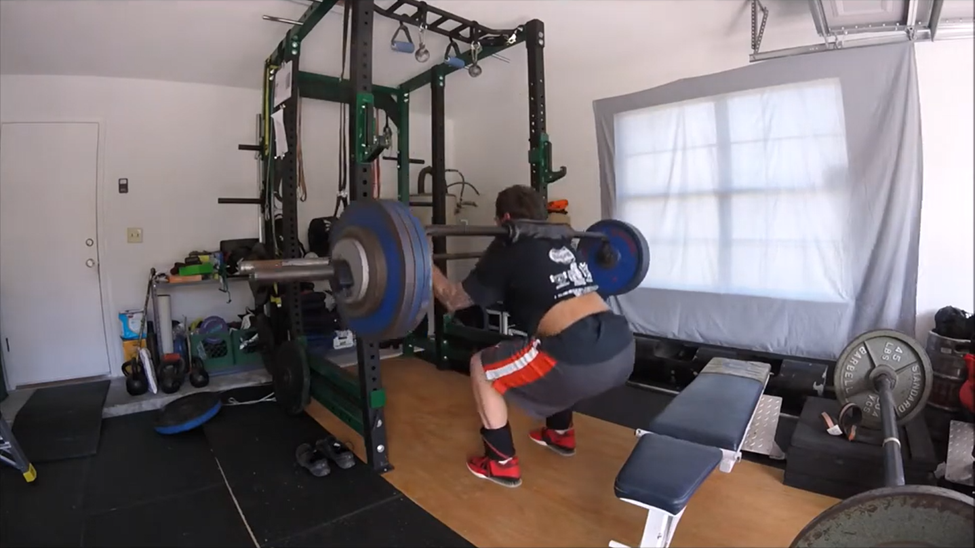
Find What Works for You
Although some of these drawbacks of training alone seem quite obvious, there are some subtleties that without having already spent an extensive amount of time lifting solo, many people would fail to notice they are missing from having a training partner or that of the team training environment. Common missing elements such as not having spotters for safety, feedback from a coaching point of view and help setting up or breakdown training are a little more clear-cut then some of the other negatives.
Many of these drawbacks are not solvable without the addition of a training partner, coach, or team in-person. So in order to continue to maximize your training by yourself, you need to properly plan how to circumvent some of these potential issues in order to get the most out of your training. A lot of that just comes from practice and actually analyzing your own individual situation.
Conclusion
Not every situation is going to be inherently positive or negative for each person. Many of the attributes you may view as a benefit could just as well be a downside from someone else. For example, just as great as it is to set your own lift times, locations and the training atmosphere, if you’re the type of person who procrastinates or can’t compartmentalize work or personal life from time allocated for training, this would detract from having a quality training session and these loose restrictions could end up being detrimental over time.
The positives and negatives of training alone all have an equal and opposite dichotomy to them. Although this article is a lot of my success and failures through navigating the art of training alone, just like nearly all strength training endeavors and programs, this isn’t the only path. Many of the attributes I personally view as positives to training alone could be the polar opposite and a concrete reason why you would not choose to lift solo. Bottom line is you need to find what works best for you and make the most of your personal situation in order to maximize the benefits of your individual training.
There are arguments for and against training independently as well as the best approaches in order to do so effectively. So whether by choice or by necessity, after reading the information covered in this article, I hope you are more prepared to maximize your training and make the most out of training alone.
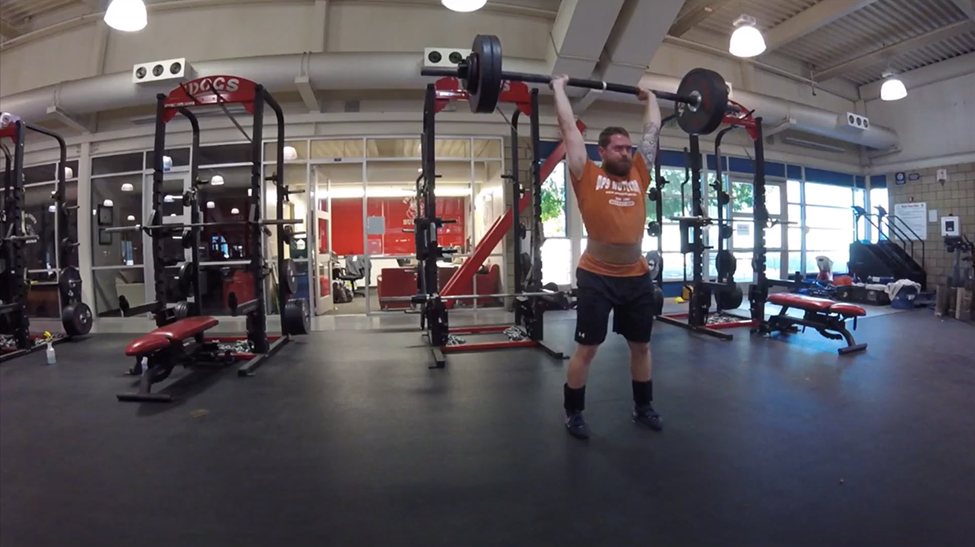
About Nick O’Brien
Currently Nick O’Brien is the Assistant Director of Sports Performance at Jacksonville University joining the staff in 2021. O’Brien came to Jacksonville by way of Fresno State University where he served as an Assistant Strength and Conditioning Coach since 2016. Prior to Fresno State he was an Assistant Strength and Conditioning Coach from 2014-2016 at Loyola University Maryland as well as spent two years as a Graduate Assistant Strength and Conditioning Coach at Salisbury University. He began his coaching career at his alma mater, Salisbury University, as a volunteer assistant (2009-2012) in addition to completing internships at American University (2015), San Diego State University (2014), Loyola University Maryland (2013),
and Georgetown University (2011).
A native of Oceanside, CA, O’Brien earned his Master’s degree in Applied Health Physiology in 2014 and his Bachelor’s degree in Exercise Science in 2012 from Salisbury University. A member of the CSCCa and NSCA, he currently holds the SCCC, CSCS, FMS, USAW-L1 and USAPL-CC professional certifications.
In addition to his coaching experience, O’Brien is a national level strongman competitor and Highland games athlete. He is a committee member of the NSCA Strongman SIG and the Host of “The Strength Game” Podcast. O’Brien is also a Second Lieutenant in the U.S. Army and currently resides in Jacksonville, FL.
Our Collaborative Planning Process allows you to prepare your project stress free by allowing our team to become your personal project manager. The real-time planning and organization of thoughts gives you back time and clarity as a leader. If you’d like to schedule a FREE CONSULTATION, please fill out this form.

Nick O’Brien
college strength and conditioning coach, national level Strongman competitor and Highland games athlete, and an Officer in the United States Army.
A native of Oceanside, CA, O’Brien earned his Master’s degree in Applied Health Physiology in 2014 and his Bachelor’s degree in Exercise Science in 2012 from Salisbury University. A member of the CSCCa and NSCA, he currently holds the SCCC, CSCS, FMS, USAW-L1 and USAPL-CC professional certifications.
In addition to his coaching experience, O’Brien is a national level strongman competitor and Highland games athlete. He is a committee member of the NSCA Strongman SIG and the Host of “The Strength Game” Podcast. O’Brien is also a Second Lieutenant in the U.S. Army and currently resides in Jacksonville, FL.
Email: coachNobrien@gmail.com Website



